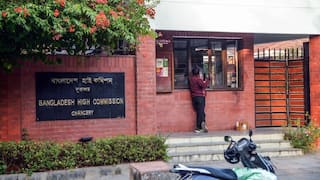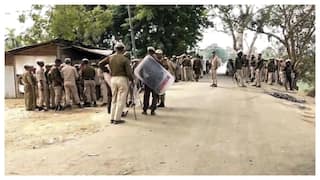Explorer
Vizag Gas Leak A Reminder Of Bhopal Gas Tragedy
Today’s gas leak at Visakhapatnam is a chilling reminder of the 1984 Bhopal gas tragedy one of the worst industrial disasters in the world.

Visakhapatnam: A father rushes to take his child for treatment at King George Hospital after a major chemical gas leakage at LG Polymers industry in RR Venkatapuram village, Visakhapatnam, Thursday, May 07, 2020. (PTI Photo) (PTI07-05-2020_000029B)
New Delhi: In December 1984, around 30 tonnes of toxic methyl isocyanate (MIC) released in the air from the Union Carbide India Limited (UCIL) plant. Picked by the breeze the invisible gas made its way to nearby areas. By the next day, hundreds were rushing to the few city hospitals complaining about nausea, vomiting, eye irritation, and breathing difficulty and many were already dead. This gas leakage from the pesticide plant in Bhopal, Madhya Pradesh also known as the Bhopal gas tragedy is considered one of the worst industrial disasters in the world by the International Labour Organization (ILO). According to official estimates, more than 3000 people died due to poisoning by the gas, but activists say that numbers are higher at least 7000-8000. The International Labour Organisation (ILO) states that over 600,000 workers and nearby inhabitants were injured due to the gas leak. Over the years the death toll due to the disaster has reached 15000. What happened Methyl isocyanate or MIC is a colourless and extremely flammable liquid chemical. It is highly volatile and can be explosive when it meets air. When it is mixed with water, the resulting reaction causes the formation of heat, methylamine, and carbon dioxide. Both the liquid and the vapors of the chemical is poisonous and can cause severe damage if any part of the body is exposed to it or it is inhaled. Even before the tragedy in 1984, there were reports of several smaller leakages at the Union Carbide plant. In 1976, Trade Unions had also highlighted that there was pollution within the plant. Several accidents with gas leak and spillage had also come to notice. Yet these were not addressed and important areas in the plant such as the safety system continued to malfunction. Watch: In October 1984, a problem in pumping was detected in a tank that was used to store liquid MIC. Since the tank stored more than the prescribed amount of MIC, the plant was shut partially for repairs. But despite the efforts liquid MIC from the tank could not be pumped out of the tank and it remained there, till in December water entered the tank. This led to a chemical reaction that led to the formation of a tremendous amount of gas. It built pressure on the tank and the tank cover blew away releasing the poisonous gas into the air. What is the effect of the gas People who were exposed to the gas leak complained of burning in the eyes, difficulty breathing, nausea and vomiting. According to a study 'The Bhopal disaster and its aftermath: a review' published in a journal by National Center for Biotechnology Information (United States) the early effects of the gas exposure that is immediately after exposure to six months are:
- Redness in the eyes, watering, ulcers, and photophobia
- Pulmonary edema and pneumonitis
- Persistent diarrhea and persistent abdominal pain
- Genetic issues such as chromosomal abnormalities and psychological effects such as anxiety and neurosis
Follow Breaking News on ABP Live for more latest stories and trending topics. Watch breaking news and top headlines online on ABP News LIVE TV
Read more

ABP Live News
Opinion





































